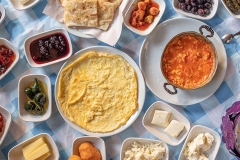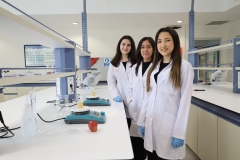
FACULTY OF ENGINEERING
Department of Food Engineering
BME 307 | Course Introduction and Application Information
| Course Name |
Biosensors
|
|
Code
|
Semester
|
Theory
(hour/week) |
Application/Lab
(hour/week) |
Local Credits
|
ECTS
|
|
BME 307
|
Fall/Spring
|
3
|
0
|
3
|
5
|
| Prerequisites |
None
|
|||||
| Course Language |
English
|
|||||
| Course Type |
Elective
|
|||||
| Course Level |
First Cycle
|
|||||
| Mode of Delivery | - | |||||
| Teaching Methods and Techniques of the Course | - | |||||
| Course Coordinator | ||||||
| Course Lecturer(s) | ||||||
| Assistant(s) | - | |||||
| Course Objectives | The objective of this course to introduce biosensors used modern medicine. Initially the course will focus on biosensors using enzymatic reactions and affinity based recognition by nucleic acids and antibodies. In the following, potentiometric, amperometric and optical fundamentals of biosensors before discussing the future of biosensor technologies. |
| Learning Outcomes |
The students who succeeded in this course;
|
| Course Description | The course covers Bioelectronic devices, Potentiometric, amperometric, Optical, Fluorescent, colorimetric and other biosensor systems, Enzyme electrodes, substrate electrodes, immunosensors, aptamer sensors, new approaches in biosensors. |
|
|
Core Courses | |
| Major Area Courses | ||
| Supportive Courses | ||
| Media and Management Skills Courses | ||
| Transferable Skill Courses |
WEEKLY SUBJECTS AND RELATED PREPARATION STUDIES
| Week | Subjects | Related Preparation |
| 1 | Introduction to Biosensors | F.‐G. Bănică, Chemical Sensors and Biosensors: Fundamentals and Applications, Wiley, 2012, ISBN 978-0-470-71066-1, Chapter 1 |
| 2 | Classification of Biosensors | F.‐G. Bănică, Chemical Sensors and Biosensors: Fundamentals and Applications, Wiley, 2012, ISBN 978-0-470-71066-1,, Chapter 1 |
| 3 | Enzymes Based Biosensors | F.‐G. Bănică, Chemical Sensors and Biosensors: Fundamentals and Applications, Wiley, 2012, ISBN 978-0-470-71066-1, Chapter 3 |
| 4 | Antibody, Protein and Peptides Based Biosensors | F.‐G. Bănică, Chemical Sensors and Biosensors: Fundamentals and Applications, Wiley, 2012, ISBN 978-0-470-71066-1, Chapter 6 |
| 5 | Nucleic Acid Based Biosensors | F.‐G. Bănică, Chemical Sensors and Biosensors: Fundamentals and Applications, Wiley, 2012, ISBN 978-0-470-71066-1, Chapter 7 |
| 6 | Immobilization of Biochemical Elements of Biosensors | F.‐G. Bănică, Chemical Sensors and Biosensors: Fundamentals and Applications, Wiley, 2012, ISBN 978-0-470-71066-1, Chapter 5 |
| 7 | MIDTERM | |
| 8 | Electrochemical Biosensors | F.‐G. Bănică, Chemical Sensors and Biosensors: Fundamentals and Applications, Wiley, 2012, ISBN 978-0-470-71066-1, Chapter 13 |
| 9 | Optical Biosensors | F.‐G. Bănică, Chemical Sensors and Biosensors: Fundamentals and Applications, Wiley, 2012, ISBN 978-0-470-71066-1, Chapter 18 |
| 10 | Thermo chemical Biosensors | F.‐G. Bănică, Chemical Sensors and Biosensors: Fundamentals and Applications, Wiley, 2012, ISBN 978-0-470-71066-1, Chapter 9 |
| 11 | Other Biosensors | F.‐G. Bănică, Chemical Sensors and Biosensors: Fundamentals and Applications, Wiley, 2012, ISBN 978-0-470-71066-1, Chapter 19 |
| 12 | Current Application of Biosensors | F.‐G. Bănică, Chemical Sensors and Biosensors: Fundamentals and Applications, Wiley, 2012, ISBN 978-0-470-71066-1, Chapter 20-23 |
| 13 | Current Application of Biosensors | F.‐G. Bănică, Chemical Sensors and Biosensors: Fundamentals and Applications, Wiley, 2012, ISBN 978-0-470-71066-1, Chapter 20-23 |
| 14 | Current Application of Biosensors | F.‐G. Bănică, Chemical Sensors and Biosensors: Fundamentals and Applications, Wiley, 2012, ISBN 978-0-470-71066-1, Chapter 20-23 |
| 15 | Review | |
| 16 | Final Exam |
| Course Notes/Textbooks | F.‐G. Bănică, Chemical Sensors and Biosensors: Fundamentals and Applications, Wiley, 2012, ISBN 978-0-470-71066-1. Pier Andrea Serra (editor), Biosensors – Emerging Materials and Applications, 2011, ISBN 978-953-307-328-6. |
| Suggested Readings/Materials | Jeong-Yeol Yoon, Introduction to Biosensors - From Electric Circuits to Immunosensors, Springer, 2013, ISBN 978-1-4419-6022-1 Pier Andrea Serra (Editor), Biosensors, 2010, ISBN 978-953-7619-99-2 |
EVALUATION SYSTEM
| Semester Activities | Number | Weigthing |
| Participation | ||
| Laboratory / Application | ||
| Field Work | ||
| Quizzes / Studio Critiques | ||
| Portfolio | ||
| Homework / Assignments |
1
|
10
|
| Presentation / Jury |
1
|
20
|
| Project | ||
| Seminar / Workshop | ||
| Oral Exams | ||
| Midterm |
1
|
30
|
| Final Exam |
1
|
40
|
| Total |
| Weighting of Semester Activities on the Final Grade |
3
|
55
|
| Weighting of End-of-Semester Activities on the Final Grade |
1
|
45
|
| Total |
ECTS / WORKLOAD TABLE
| Semester Activities | Number | Duration (Hours) | Workload |
|---|---|---|---|
| Theoretical Course Hours (Including exam week: 16 x total hours) |
16
|
3
|
48
|
| Laboratory / Application Hours (Including exam week: '.16.' x total hours) |
16
|
0
|
|
| Study Hours Out of Class |
16
|
2
|
32
|
| Field Work |
0
|
||
| Quizzes / Studio Critiques |
0
|
||
| Portfolio |
0
|
||
| Homework / Assignments |
1
|
5
|
5
|
| Presentation / Jury |
1
|
20
|
20
|
| Project |
0
|
||
| Seminar / Workshop |
0
|
||
| Oral Exam |
0
|
||
| Midterms |
1
|
20
|
20
|
| Final Exam |
1
|
25
|
25
|
| Total |
150
|
COURSE LEARNING OUTCOMES AND PROGRAM QUALIFICATIONS RELATIONSHIP
|
#
|
Program Competencies/Outcomes |
* Contribution Level
|
||||
|
1
|
2
|
3
|
4
|
5
|
||
| 1 | Being able to transfer knowledge and skills acquired in mathematics and science into engineering, | |||||
| 2 | Being able to identify and solve problem areas related to Food Engineering, | |||||
| 3 | Being able to design projects and production systems related to Food Engineering, gather data, analyze them and utilize their outcomes in practice, | |||||
| 4 | Having the necessary skills to develop and use novel technologies and equipment in the field of food engineering, |
|||||
| 5 | Being able to take part actively in team work, express his/her ideas freely, make efficient decisions as well as working individually, |
|||||
| 6 | Being able to follow universal developments and innovations, improve himself/herself continuously and have an awareness to enhance the quality, |
|||||
| 7 | Having professional and ethical awareness, |
|||||
| 8 | Being aware of universal issues such as environment, health, occupational safety in solving problems related to Food Engineering, | |||||
| 9 | Being able to apply entrepreneurship, innovativeness and sustainability in the profession, |
|||||
| 10 | Being able to use software programs in Food Engineering and have the necessary knowledge and skills to use information and communication technologies that may be encountered in practice (European Computer Driving License, Advanced Level), |
|||||
| 11 | Being able to gather information about food engineering and communicate with colleagues using a foreign language ("European Language Portfolio Global Scale", Level B1) |
|||||
| 12 | Being able to speak a second foreign language at intermediate level. |
|||||
| 13 | Being able to relate the knowledge accumulated during the history of humanity to the field of expertise |
|||||
*1 Lowest, 2 Low, 3 Average, 4 High, 5 Highest
NEWS |ALL NEWS

Online 'weight loss' period
The increase in time spent at home to protect against coronavirus and the habit of sedentary life caused a "weight" crisis for

The Aegean is distributing healing
The fear of catching coronavirus, which is transmitted to more than 73 million people worldwide, and the increase in flu cases with

Pandemic changed eating habits
The coronavirus, which negatively affected life in many issues from daily life to work and social interaction, also changed the eating habits

HIGH-SCHOOL STUDENTS EXPERIENCED COLLEGE IN FOOD ENGINEERING LABORATORIES
“SCIENCE DAYS” event was organized by Department of Food Engineering in Izmir University of Economics. This event aimed to teach science in

STUDENTS OF FOOD ENGINEERING DEPARTMENT DEVELOPED 'ATRICHOKE PASTE' FOR FIRST INTERNATIONAL URLA ARTICHOKE FESTIVAL
Most of the attenders enjoyed the 'Artichoke Paste', developed by the students of Food Engineering Department.

MAINTAINING HEALTHY EATING HABITS DURING HOLIDAY SEASON!
As the students got their report cards and started a long summer holiday, the experts pointed out the importance of not to


